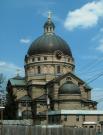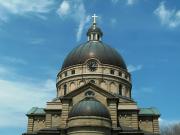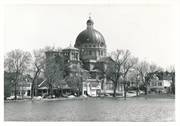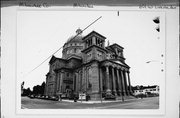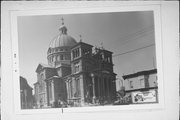| Additional Information: | A 'site file' exists for this property. It contains additional information such as correspondence, newspaper clippings, or historical information. It is a public record and may be viewed in person at the Wisconsin Historical Society, State Historic Preservation Office.
HOUSES OF WORSHIP SURVEY. HABS WI-258. BUILDING WAS COMPLETED IN 1902. Church can accommodate 2,000 people. Much of the building material was salvaged from the Chicago Post Office by Fr. Grutza for a cost of $20,000. 500 railway flatcars were required to transport the materials to Milwaukee. Much of the construction work was carried out by parishioners. Consecrated by Bishop Rhode of Green Bay in 1928, St. Josaphat's was designated a basilica by Pope Pius XI in 1929 and thus became the first basilica in this country built for Polish-Americans.See National Register of Historic Places form.
St. Josaphat's Basilica is a jubilant proclamation of religious devotion and ethnic pride. The massive, domed stone church’s Beaux-Arts design affirms the growth and influence of Milwaukee’s Polish community, many of whom literally gave every penny they could spare to build it. Parishioners donated labor to build the church, but cost overruns brought financial hardship to the twelve-thousand-member parish. Families even mortgaged their homes to lend or donate money to the project.
St. Josaphat's original design called for a brick structure trimmed with terracotta. But when Father Wilhelm Grutza, the parish priest, went to Chicago to buy brick, he discovered a low-cost supply of fine cut limestone, available with the imminent demolition of the Chicago Post Office. He purchased the salvage rights, then had the building disassembled and shipped to Milwaukee on five hundred railroad flatcars. The materials were reassembled according to architect Erhard Brielmaier's plans, modeled on St. Peter’s Basilica in Rome. Cruciform, the church centers on a massive copper dome, 250 feet high. A Corinthian colonnade, pediments, and two square bell towers dominate the dramatic north (Lincoln Avenue) facade. Tall, narrow, round-topped tracery windows light the sides.
Even after the church opened, it took nearly thirty years to complete the magnificent interior decoration. With extensively gilded and painted plasterwork, an elaborate marble pulpit and wood and marble shrines and altars were added. Art-glass windows imported from Innsbruck, Austria, were gradually installed throughout the church. New Berlin’s Conrad Schmitt Studios painted the large mural behind the main altar, and in 1928 Italian artist Gonippo Raggi executed the beautiful decorative painting depicting biblical scenes, episodes in the life of St. Francis, and important events pertaining to Polish saints and history.
Few Wisconsin churches approach the scale and grandeur of St. Josaphat's. Dedicated in 1901 after five years of construction, many visitors to St. Josaphat's compare its splendor to European churches. In 1929, Pope Pius XI conferred basilica status on St. Josaphat's to honor the parish's strong expression of religious faith and its artistic achievement in the church design. At the time, St. Josaphat's was only the third basilica designated in America, among thousands of Roman Catholic churches. |
|---|
| Bibliographic References: | MILWAUKEE ETHNIC CHURCH TOUR, CITY OF MILWAUKEE DEPARTMENT OF CITY DEVELOPMENT, 1994.
MILWAUKEE JOURNAL SENTINEL 10/29/1995.
MILWAUKEE JOURNAL SENTINEL 12/25/1995.
MILWAUKEE JOURNAL SENTINEL 1/11/1996.
Milwaukee Journal Sentinel 3/31/1997.
Milwaukee Journal Sentinel 7/7/1997.
Milwaukee Journal Sentinel 10/19/1998.
Pagel, p. 23.
Buildings of Wisconsin manuscript.
Pagel, Mary Ellen & Virginia A. Palmer, University Extension University of Wisconsin, Guides to Historic Milwaukee: Walker's Point and South, 1969. |
|---|

